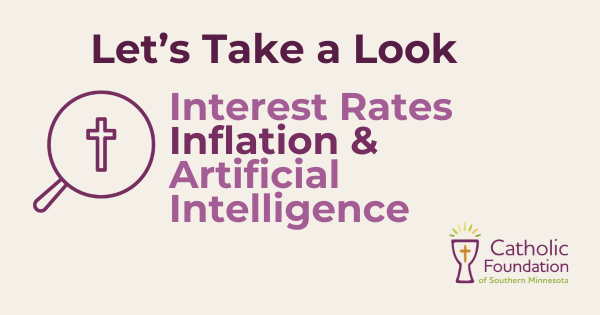

Last week, the Federal Reserve lowered its benchmark interest rate by 25 basis points, bringing it to a range of 4.00%–4.25%. This marks the first cut of 2025, with two more meetings scheduled for October 28–29 and December 9–10. "Fed officials said they expect to reduce their key rate twice more this year, but just once in 2026. According to the CME FedWatch Tool, there’s a 93% chance of another cut in October and 92% in December, potentially lowering rates by a total of 0.50%–0.75%.
This news is significant—but it means more when we look at a bigger picture.
What History Tells Us About Rate Cuts, Inflation & Stock Prices
The Federal Reserve itself acknowledges that monetary policy affects inflation through its influence on financial conditions and expectations. Historically, when the Fed lowers interest rates, borrowing becomes cheaper, demand increases, and inflation tends to rise—especially if the economy is already running hot.
A recent Fed study analyzing 149 easing episodes across advanced economies found that only 11 led to successful inflation control. In most cases, inflation remained elevated or rebounded after cuts. In short: rate cuts don’t always tame inflation—they can reignite it.
Here's another nugget to consider, according to an analysis done by Quantified Strategies, when the Fed cuts rates near an S&P 500 record high - which has happened 20 times - the market has been higher one year later 100% of the time. The average 12-month return following such cuts was approximately 13.9%, with a median return of 9.8%. JPMorgan also ran similar 40-year analysis and found that in 12 cases where the Fed cut rates with the S&P 500 within 1% of its all-time high, the market was higher a year later every time, with an average return of around 15%.
Did you Hear The Labor Market Just Got a Reality Check?
On September 9, 2025, the Bureau of Labor Statistics revised its nonfarm payroll data downward by 911,000 jobs for the 12 months preceding March 2025. That’s nearly a million fewer jobs than previously reported. The biggest losses came from leisure and hospitality (-176,000), professional services (-158,000), and retail (-126,200). Which tells us jobs have been down for some time - what we have been feeling in our communities - hard times, lower donations - is real.
If this trend continues, we could see fewer paychecks, less consumer spending, and a contraction in GDP. But here’s where I wonder if the story takes a turn.
Enter AGI: Artificial General Intelligence
AGI, or Artificial General Intelligence, refers to AI systems capable of performing most tasks as well as—or better than—humans. Unlike narrow AI, which excels at specific functions - for instance today AI it's fantastic at "Please write me a meeting recap email with next steps," "Please review and summarize trends in this donation data," or "Please suggest a lesson plan to teach elementary students about God's forgiveness." Sidenote: If you use AI today for prompts like these, keep in mind you need to protect donor data by removing personal information before sharing anything with AI and always fact check information sources.
Now, compare that with AGI. Rather than a simple task completion. AGI will be able to reason, learn, and adapt across domains. For instance, if you asked it to, AGI could complete an entire capital campaign for you from strategic planning, feasibility studies, message development, (digital) stakeholder engagement, campaign execution including performance optimization and post-campaign analysis. AGI wouldn’t just complete these steps—it could reason across them, adapting to new information, theological nuance, and human emotion. It would integrate faith, analytics, and storytelling the way you do, but at scale and speed. Yes, it's a little scary!
According to The AGI Clock, expert consensus predicts AGI will arrive by June 2030. Leaders at top AI companies including OpenAI, Anthropic, and DeepMind have all stated publicly that they expect AGI within the next 3–5 years. However, if you monitor the buzz of thought leaders on YouTube, I'm hearing functional AGI could be available as soon as 2027.
There is no way AGI will not dramatically reshape the labor market. We might not know exactly how yet but we can guess that jobs in tech, customer service, logistics, and even education may be automated. But here’s the twist: fewer jobs don’t necessarily mean recession or a down stock market.
A Hypothesis: Fewer Workers, Higher Profits?
Imagine you run a restaurant. Suddenly, you no longer pay for food—your costs drop dramatically, and your profits rise. Now apply that logic to labor. If companies can reduce payroll expenses through AGI, their profit margins may expand significantly.
Publicly traded companies with reduced labor costs could see earnings surge, driving up stock prices.
Recap
I know - that was a lot. So, here's a recap of the takeaways and my hypothesis.
- Rate Cuts impact on inflation & stock prices
- The Fed cut rates on September 17, 2025, with more cuts expected. Historical data shows rate cuts often lead to inflation
- The September 17 rate cut occurred near an S&P 500 all-time high. Historical data shows that rate cuts timed with S&P 500 all-time highs will increase stock prices 1 year later
- Jobs Forecast
- Nearly 1 million jobs were revised out of the labor market on September 9, 2025
- AGI may be fully functional by 2030 or sooner, reshaping employment
- Fewer jobs could mean higher corporate profits and rising stock prices
What This Could Mean for Catholic Organizations
For Catholic parishes, schools, and ministries, this moment invites strategic reflection. Inflation may erode the value of cash. Job losses may reshape giving patterns. But the stock market could rise—at least initially.
To combat inflation, Catholic organizations should consider reallocating cash into tangible assets. The most accessible tangible asset? Equities. Which my hypothesis tells me are a perfect hedge to make today, days after the Fed rate cut was aligned with an S&P 500 all-time high. A perfect way to preserve purchasing power and grow mission-aligned resources
If you'd like to talk more about your current portfolio or investing strategy, please give me a call or email. At the Catholic Foundation of Southern Minnesota offer an unmatched solution. Here are a few things to about us:
- Over $45 million under management
- 35+ years of proven investment returns
- No withdrawal fees and full access to your funds any time
- Advised by The Concord Advisory Group, a top-tier fiduciary institution
- Investments stay local, supporting our Catholic community
Let’s steward wisely. Let’s invest faithfully.
Elizabeth Williams, 507-218-40098, ewilliams@catholicfsmn.org

